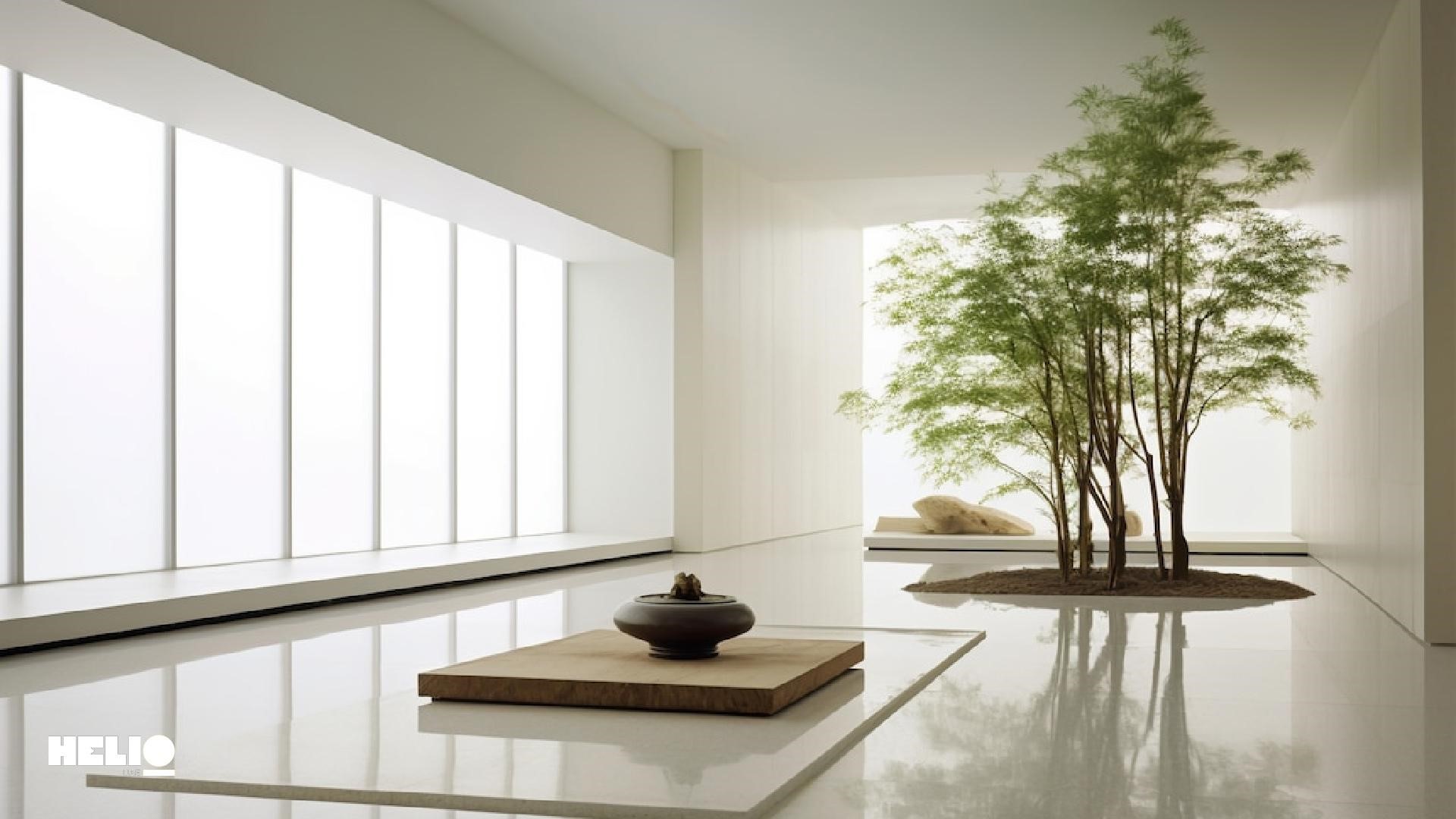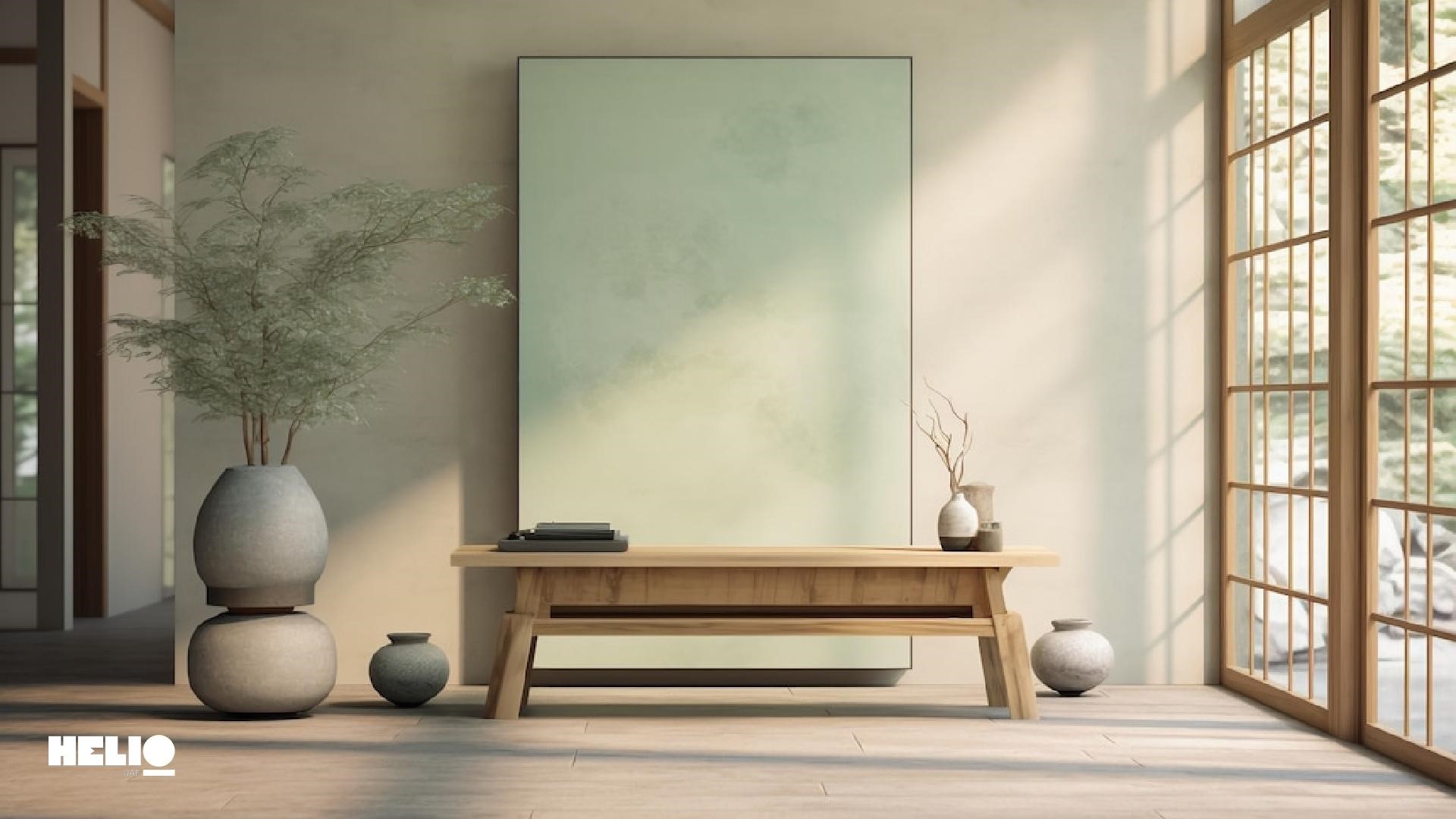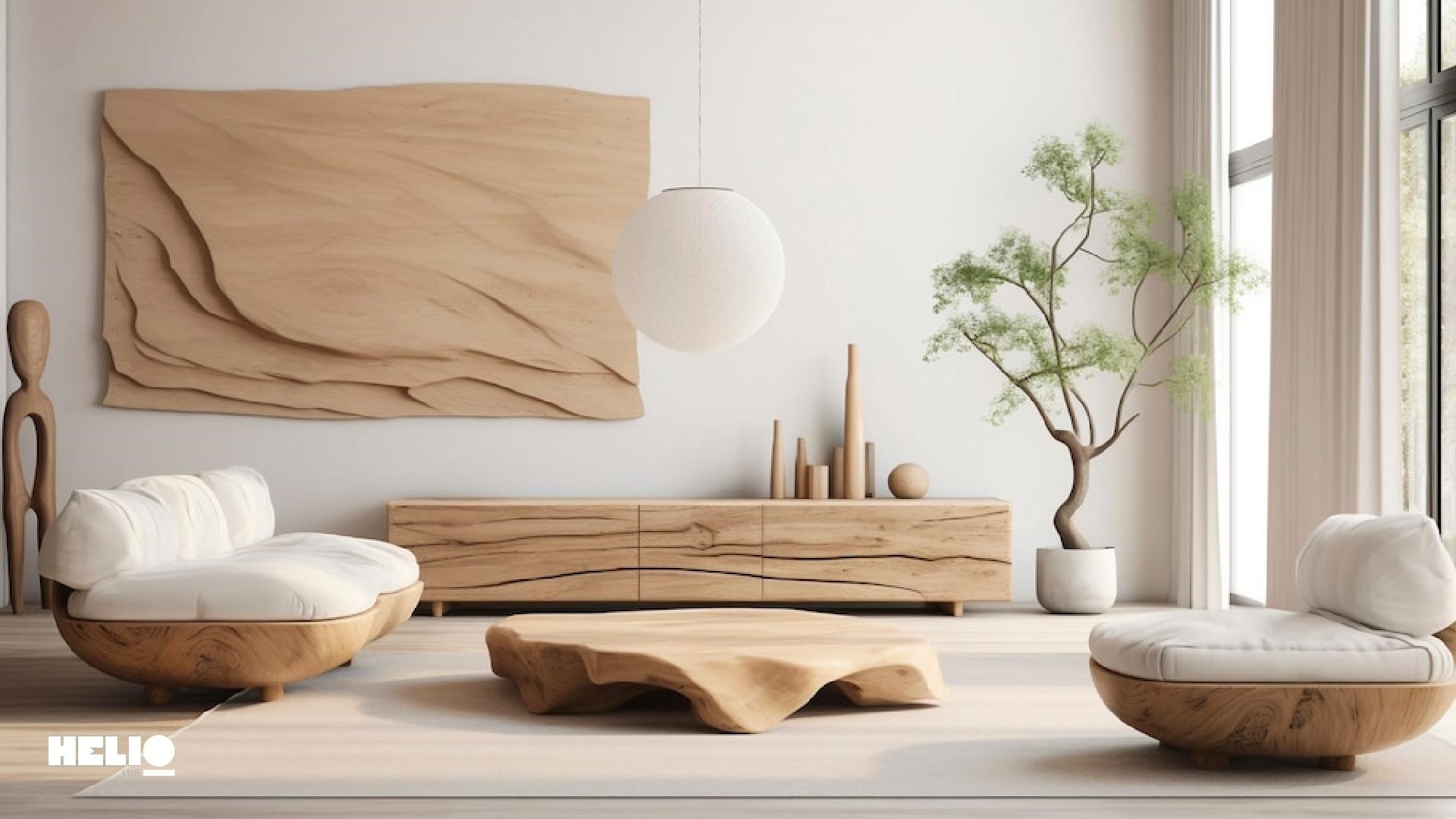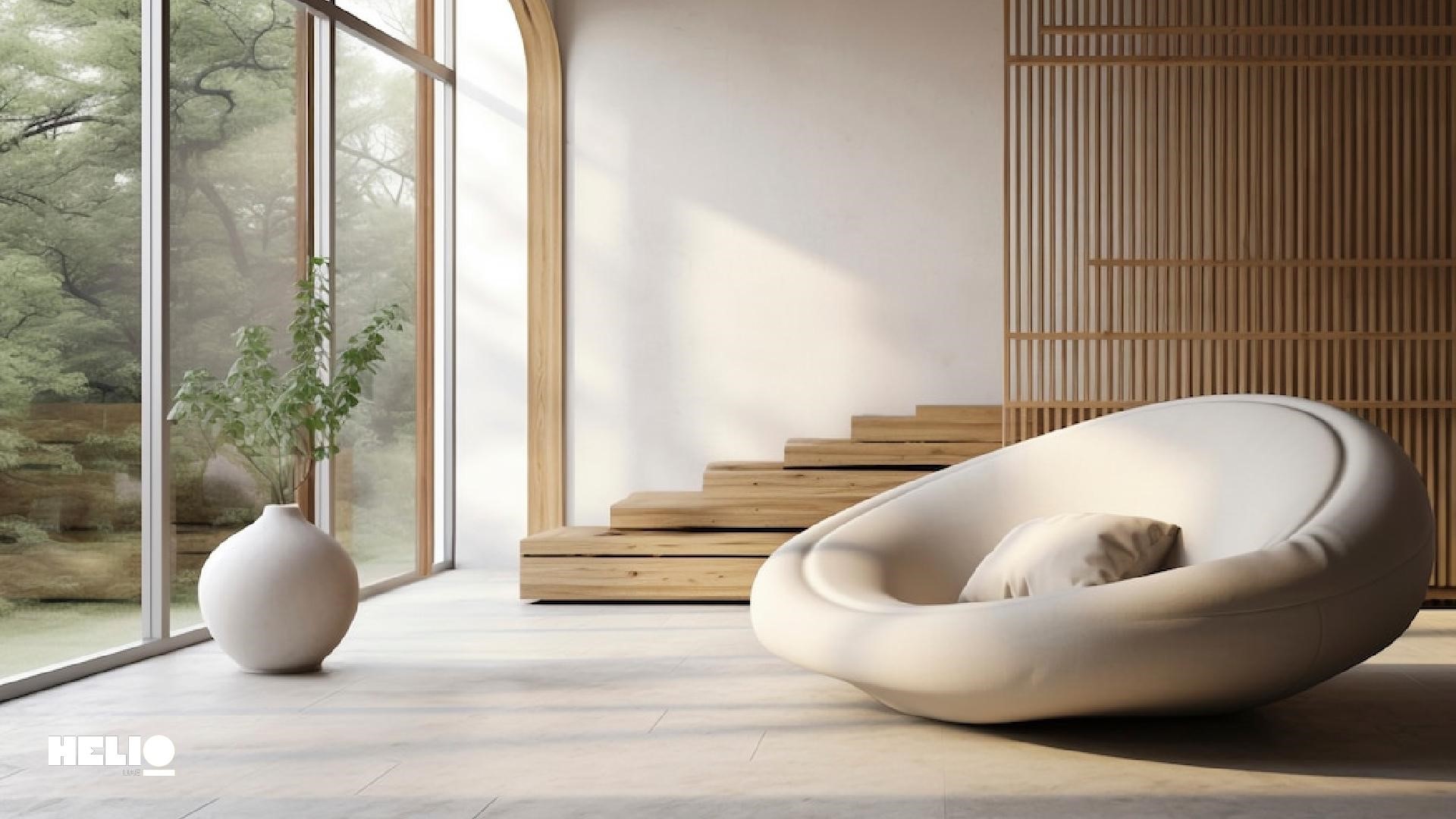Finding peace and tranquility at home is essential. Welcome to the world of Zen living rooms—spaces designed to be oases of calm and relaxation, inspired by the Zen lifestyle that promotes mindfulness, simplicity, and harmony. This blog takes you through the most serene and beautifully designed Zen living rooms, perfect for homeowners, interior design enthusiasts, and followers of the Zen lifestyle. Prepare to transform your living space into a sanctuary of peace.
Zen design principles are all about simplicity, natural elements, and harmony. These elements come together to create spaces that promote relaxation and mental well-being. In this post by Helio Archi, you’ll discover the essential aspects of Zen design, innovative ideas, practical tips, inspiring case studies, and DIY projects. These will help you create a Zen paradise in your living room, all while keeping things simple and stress-free.
Essential Elements of Zen Living Rooms
The first step in creating a Zen living room is understanding the essential elements of this design style. Here are the elements to keep in mind:
Minimalist Furniture Suitable for Living Room Zen Style
Minimalism is at the heart of Zen design. When choosing furniture, focus on simplicity and functionality. Opt for pieces with clean lines and avoid overly ornate designs. Minimalist furniture helps create an uncluttered and peaceful environment, essential for a Zen-inspired space. Simple items like low-profile sofas, sleek coffee tables, and streamlined shelving units are perfect.
Natural Materials Used in Zen Living Room Ideas
Bringing natural materials such as wood, stone, and natural fabrics into your living can profoundly be calming. Wooden elements, whether in furniture or decor, add warmth and earthiness. Stone surfaces offer an excellent, calming touch. Natural fabrics like cotton and linen provide softness and comfort, enhancing the overall tranquility of the space.
Palette Living Room Asian Zen Interior Design With Neutral Color
A neutral color palette is not just a suggestion; it’s a vital element in achieving a Zen living room. Soft, earthy beige, white, and gray tones create a soothing ambiance. These colors evoke a sense of calm and help to declutter the room visually. You can add subtle muted colors for variety, but the palette should remain understated and harmonious, ensuring a serene and peaceful living space.
Zen Looking at the Living Room with Natural Light
Maximizing natural light is crucial for a Zen living room. Large windows or glass doors can flood the space with sunlight, creating a bright and inviting atmosphere. If natural light is limited, use soft, ambient lighting to mimic the effect. Light fixtures with dimming capabilities allow you to adjust the lighting to suit different moods and times of day.

Design Ideas for Zen Living Rooms
Now that you’re familiar with the essential elements of Zen design, it’s time to explore some design ideas for your living room. Here are a few inspirations to get you started:
Open Spaces Zen Living Room
Creating open, uncluttered spaces is fundamental to Zen design. Open layouts promote the flow of energy and reduce feelings of confinement. Arrange furniture to enhance space and avoid overcrowding. Incorporating open shelving and multi-functional furniture helps maintain an open, airy feel.
Zen Living Room Indoor Plants
Adding greenery to your living room brings a touch of nature indoors. Plants like bonsai trees, bamboo, and succulents are excellent for a Zen-inspired space. They add visual interest and contribute to a calming environment. Indoor plants improve air quality, further enhancing the tranquility of your living area.
Water Features of Zen Living Room
Water features such as small fountains or tabletop waterfalls can add a serene and soothing element to your living room. The sound of flowing water promotes relaxation and peace. Water features can be as simple or elaborate as you like, but even the smallest addition can significantly impact the process.
Japanese Influence on Zen Living Room
Incorporating Japanese design elements can enhance your living room’s Zen aesthetic. Shoji screens, tatami mats, and low-profile furniture like futons and floor cushions add an authentic touch. These traditional Japanese elements complement the minimalist and natural aspects of Zen design.
Soft Textures of Zen Living Room
Introduce soft textures through rugs, cushions, and throws to create a cozy and inviting atmosphere. Opt for natural materials such as wool, cotton, and linen to maintain the Zen focus on natural elements. Soft textures not only add comfort but also enhance the sensory experience of the space.
Simple Artwork of Zen Living Room
Choose minimalistic and nature-inspired art pieces to adorn your walls. Simple line drawings, monochromatic prints, and artwork featuring natural scenes such as landscapes or botanical illustrations fit nicely within a Zen aesthetic. The artwork should complement the overall design without overwhelming the space.
Meditation Areas in Zen Living Room
A dedicated meditation and mindfulness space can enhance your living room’s Zen qualities. A quiet corner with comfortable seating, soft lighting, and calming decor can be a personal retreat for relaxation and reflection. Incorporate floor cushions, incense, and a small altar to personalize your meditation area.

Decor Tips and Tricks for Zen Living Rooms
In addition to incorporating essential elements and design ideas, there are some practical tips and tricks you can use to enhance the Zen vibe in your living room:
Zen Living Room Decluttering
Keeping the living room tidy and organized is essential for maintaining a Zen atmosphere. Regularly declutter to remove unnecessary items that disrupt the sense of calm. Use storage solutions like baskets, drawers, and hidden compartments to keep belongings out of sight and ensure a neat and orderly space.
Balanced Layout of Zen Living Room
Symmetry and balance in furniture arrangement are vital for creating a harmonious living room—position furniture to promote balance and avoid overcrowding. A balanced layout enhances energy flow and contributes to a tranquil environment.
Zen Living Room Low Furniture
Low-profile furniture helps create a grounded feel in your living room. Pieces such as low sofas, coffee tables, and floor cushions foster a connection to the earth and promote stability. Low furniture also enhances the feeling of openness and spaciousness in the room.
Zen Living Room Natural Scents
Using essential oils and natural fragrances can elevate the sensory experience of your living room. Scents such as lavender, sandalwood, and eucalyptus promote relaxation and calm. Use diffusers, scented candles, or incense to introduce natural scents into the space.
Zen Living Room Earthy Elements
To enhance the Zen aesthetic, incorporate decor from natural materials like stones, bamboo, and rattan. Earthy elements add texture and visual interest while maintaining a connection to the natural world. Small decor items like stone sculptures, bamboo plants, and rattan baskets can significantly impact.
Zen Living Room Textural Contrast
Mixing different textures adds depth and visual interest to your living room. Combine smooth surfaces with rough textures, soft fabrics with rugged materials, and matte finishes with glossy ones. Textural contrast keeps the space dynamic while maintaining the overall Zen aesthetic.
DIY Zen Decor Projects
Creating a Zen-inspired living room doesn’t have to break the bank. Here are a few easy DIY projects you can try to add some Zen elements to your space:
Creating a Zen Garden
A mini Zen garden is a simple and beautiful addition to any living room. To create your garden, use a shallow tray, sand, and small rocks. For a meditative activity, rake patterns into the sand. To personalize your garden, add elements like moss, succulents, or small statues.
DIY Natural Art
Create wall art using natural materials such as leaves, twigs, and stones. Arrange these items on a canvas or frame and secure them with glue. This project adds a personal touch to your decor and brings elements of nature into your living room.
Handmade Cushions and Throws
Sew your cushions and throws using natural fabrics like cotton, linen, or wool. Choose neutral or earthy colors to match your Zen aesthetic. Handmade soft furnishings add comfort and personalization to your living room while enhancing its tranquility.
Building a Water Feature
A DIY water feature can be a beautiful and calming addition to your living room. Use a large bowl, a small water pump, and decorative stones or pebbles to create a tabletop fountain. The sound of flowing water promotes relaxation and adds a serene element to your space.

Expert Tips and Insights
For further inspiration and guidance, here are some expert tips and insights on creating a Zen living room:
Quotes and Tips from Interior Design Experts
Interior design experts emphasize the importance of simplicity, natural elements, and balance in creating Zen living rooms. “A Zen-inspired space should evoke a sense of calm and tranquility,” says designer Jane Smith. “Focus on natural materials and neutral colors to promote relaxation.”
Common Mistakes to Avoid
Avoid cluttering the space with too many decor items or furniture pieces. Stick to the essentials and maintain an open, airy feel. Overcomplicating the design with bold colors or overly ornate decor can disrupt the sense of calm. Keep it simple and natural for the best results.
Future Trends in Zen Living Room Design
As design trends evolve, so does the Zen aesthetic. In the future, we expect to see more use of technology in creating Zen living rooms.
Integration of Smart Home Technology
Future Zen living rooms will likely integrate smart home technology with Zen principles. Smart lighting systems that mimic natural light, automated temperature control, and voice-activated assistants can enhance convenience and comfort without disrupting the Zen aesthetic.
Sustainable and Eco-Friendly Decor
Sustainable and eco-friendly decor trends are becoming increasingly popular. Using recycled materials, sustainable wood, and energy-efficient lighting aligns with the Zen principle of harmony with nature. These choices promote environmental responsibility while creating a beautiful and serene living space.
Evolving Aesthetics in Zen Design
Zen design is evolving to incorporate modern aesthetics. Contemporary Zen living rooms may feature sleek, minimalist furniture, bold architectural elements, and innovative use of materials. The core principles of simplicity, natural elements, and harmony remain, but the execution reflects modern tastes and sensibilities.
Conclusion
Zen living rooms offer a serene and beautiful escape from the chaos of everyday life. You can create a tranquil space that promotes relaxation and well-being by incorporating minimalist furniture, natural materials, a neutral color palette, and maximizing natural light.
Remember to keep your space decluttered, balanced, and infused with soft textures, natural scents, and earthy elements. Whether you’re inspired by traditional Japanese design, modern aesthetics, or coastal themes, there’s a Zen living room style to suit your taste.
Ready to transform your living space into a Zen paradise? Explore more Zen-inspired living room ideas and create a space that genuinely resonates with your spirit. For personalized advice and expert design solutions, reach out to our team of interior design specialists today!





